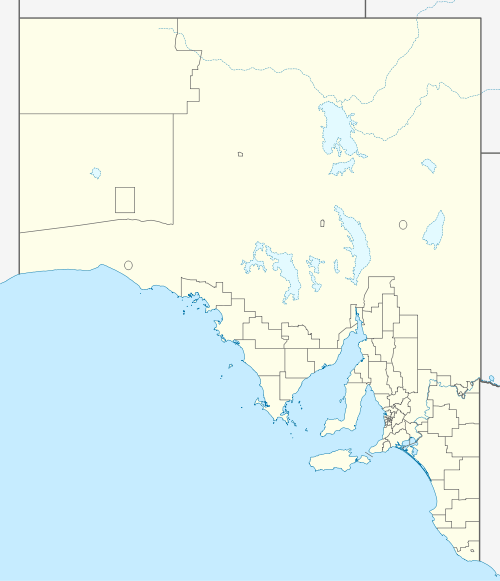Duck Ponds, South Australia
Duck Ponds is a locality in the Australian state of South Australia located on the Eyre Peninsula in the state's west about 258 kilometres (160 mi) west of the state capital of Adelaide, about 51 kilometres (32 mi) south of the municipal seat of Cummins and about 6 kilometres (3.7 mi) west of the city of Port Lincoln.[1][4]
| Duck Ponds South Australia | |||||||||||||||
|---|---|---|---|---|---|---|---|---|---|---|---|---|---|---|---|
 Duck Ponds | |||||||||||||||
| Coordinates | 34°43′22″S 135°46′59″E[1] | ||||||||||||||
| Population | 289 (2016 census)[2] | ||||||||||||||
| Established | 16 October 2003[3] | ||||||||||||||
| Postcode(s) | 5607[4] | ||||||||||||||
| Time zone | ACST (UTC+9:30) | ||||||||||||||
| • Summer (DST) | ACST (UTC+10:30) | ||||||||||||||
| Location | |||||||||||||||
| LGA(s) | District Council of Lower Eyre Peninsula[1] | ||||||||||||||
| Region | Eyre Western[1] | ||||||||||||||
| County | Flinders[1] | ||||||||||||||
| State electorate(s) | Flinders[5] | ||||||||||||||
| Federal Division(s) | Grey [6] | ||||||||||||||
| |||||||||||||||
| |||||||||||||||
| Footnotes | Locations[1][4] Adjoining localities[1] | ||||||||||||||
Its boundaries were created on 16 October 2003 for the "long established name." On 22 December 2011, a portion was added to the adjoining locality of Tulka.[1][3]
The Flinders Highway forms part of the locality's north-eastern boundary with the locality of Boston while the highway's heavy vehicle by-pass, the Western Approach Road, passes through the eastern side of the locality from the north-west on its way to the port facility in Port Lincoln.[1] The Eyre Peninsula Railway which also passes through Duck Ponds in an alignment similar to the by-pass road, forms part of its southern boundary and hosts two railway stations – Grantham in the south which was established as Five Mile Siding about 1942 and Ducks Ponds in the locality's centre which was established in 1911.[1] The Port Lincoln Prison occupies land in the locality's north-east corner while the Kathai Conservation Park, a protected area, is located in its south-east corner.[8][9]
Land use within Duck Ponds principally consists of agricultural activities such as broadacre cropping and grazing. Land use is subject to statutory control in order to manage the aquifer system existing within Duck Ponds and adjoining localities.[10][1]
The 2016 Australian census which was conducted in August 2016 reports that Duck Ponds had a population of 289 people.[2]
Duck Ponds is located within the federal division of Grey, the state electoral district of Flinders and the local government area of the District Council of Lower Eyre Peninsula.[6][1][5]
References
- "Search result for Duck Ponds, LOCB' with the following datasets selected - 'Local Government areas', 'SA Government Regions', 'Counties', 'Postcode', 'Suburbs and Localities', 'Land Development Plan Zone Categories', 'Roads', 'Railways' and 'Gazetteer'". Retrieved 15 March 2018.
- Australian Bureau of Statistics (27 June 2017). "Duck Ponds". 2016 Census QuickStats. Retrieved 15 March 2018.

- "GEOGRAPHICAL NAMES ACT 1991, Notice to Assign Boundaries and Names to Places" (PDF), The South Australian Government Gazette: 3796, 16 October 2003, retrieved 15 March 2018
- "Postcode for Duck Ponds, South Australia". Postcodes Australia. Retrieved 15 March 2018.
- "District of Flinders Background Profile". Electoral Commission SA. Retrieved 1 January 2018.
- "Federal electoral division of Grey" (PDF). Australian Electoral Commission. Retrieved 27 December 2017.
- "Monthly climate statistics: Summary statistics Summary statistics North Shields (Port Lincoln AWS) (nearest weather station)". Commonwealth of Australia , Bureau of Meteorology. Retrieved 15 March 2018.
- "Search results for "228 Pound Lane, Duck Ponds, SA, 5607" with the following datasets selected - 'Suburbs and Localities' and 'Topographic Map' selected". Location SA Map Viewer. South Australian Government. Retrieved 15 March 2018.
- "Search results for 'Duck Ponds Conservation Park' with the following datasets selected - 'suburbs and localities', 'Hundreds', 'NPW and Conservation Reserve Boundaries' and;gazetteer'". Location SA Map Viewer. Government of South Australia. Retrieved 1 January 2018.
- "Development Plan - Lower Eyre Peninsula (DC) Consolidated – 28 February 2017" (PDF). South Australian Government. pp. 194, 221 and 292–300. Retrieved 25 December 2017.